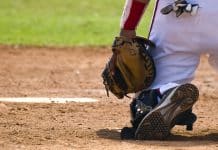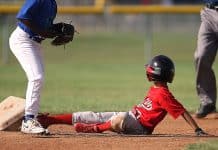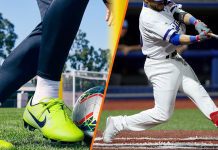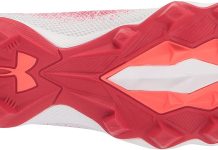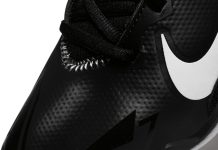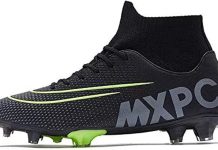Are you an avid baseball player contemplating whether to use your trusty football cleats on the diamond? In this article, we address the intriguing question of whether it is acceptable to use football cleats for playing baseball. While both sports require sturdy and reliable footwear, there are certain nuances and unique demands specific to baseball that may make this choice less than ideal. Join us as we explore the advantages and disadvantages of using football cleats for baseball and help you make an informed decision about your game-day gear.
Advantages of Football Cleats for Baseball
Review contents
Enhanced Traction on Grass
One of the biggest advantages of using football cleats for baseball is the enhanced traction they provide on grass. Football cleats are designed with longer and more widely spaced studs or spikes on the sole, which allows for better grip and traction on natural grass surfaces. This can be especially beneficial in baseball, where players need to quickly change direction, sprint, and make decisive movements on the field. The added traction of football cleats can help players maintain their balance and stability, allowing them to perform at their best.
Durable and Sturdy Construction
Another advantage of football cleats for baseball is their durable and sturdy construction. Football cleats are designed to withstand the rigorous demands of football, which often involves running, tackling, and playing on various surfaces. This durability makes them well-suited for the challenges of baseball as well. The tough materials and reinforced stitching of football cleats ensure that they can withstand the regular wear and tear of running on the baseball field, making them a long-lasting option for players looking for reliable footwear.
Wide Variety of Styles and Designs
Football cleats also offer a wide variety of styles and designs, providing players with the opportunity to express their personal style on the baseball field. Whether you prefer a classic and streamlined design or a more bold and flashy look, there is a football cleat out there to suit your taste. With different color options, patterns, and customizable features, football cleats allow players to not only enhance their performance but also showcase their individuality and sense of fashion.
Disadvantages of Football Cleats for Baseball
Inadequate Foot Support
One of the main disadvantages of using football cleats for baseball is the potential lack of foot support they provide. Football cleats are primarily designed to support the specific movements and actions required in football, such as quick bursts of speed and lateral movements. In baseball, however, players often need more support in the arches of their feet and around the ankles to prevent injuries and maintain proper form. Football cleats may not offer the necessary support in these areas, which could lead to discomfort or even injury on the baseball field.
Lack of Sideways Stability
Football cleats are also known to have a lack of sideways stability when compared to cleats specifically designed for baseball. In baseball, players need to make sudden lateral movements, like quick side-to-side shuffling or pivoting. The design of football cleats may not provide the same level of stability during these movements, which can increase the risk of ankle sprains or slips on the field. Proper sideways stability is crucial in baseball to prevent injuries and maintain optimal performance, and football cleats may not fulfill this requirement.
Potentially Damaging to Baseball Fields
Football cleats typically have longer and sharper studs or spikes compared to baseball cleats. While this feature is beneficial for providing better traction on grass, it can also be potentially damaging to the baseball field. The longer studs can dig deeper into the turf, causing more significant divots and potentially leading to field damage. In some cases, the use of football cleats on baseball fields may even be prohibited to protect the integrity of the playing surface. It’s essential for players to consider the impact their footwear may have on the field and abide by any league or field regulations regarding cleat usage.
Considerations when Using Football Cleats for Baseball
League Regulations and Approval
Before using football cleats for baseball, it’s crucial to check and comply with any league regulations regarding footwear. Some baseball leagues may have specific rules regarding the type of cleats that are allowed, and the use of football cleats may be prohibited. Understand the guidelines set by your league and ensure that your chosen footwear meets the requirements to avoid any penalties or disqualification during games.
Field Conditions and Maintenance
The condition of the baseball field also plays a significant role in determining whether football cleats are suitable. If the field is well-maintained and provides good traction, football cleats may be a viable option. However, if the field is uneven, muddy, or has an unstable surface, it may be more appropriate to switch to cleats specifically designed for baseball. Assess the field conditions before each game and consider the potential impact of your footwear choice on your performance and safety.
Player Position and Playing Style
Consider your position and playing style when deciding whether football cleats are suitable for baseball. Different positions may require different types of movement and footwork, which can affect the effectiveness of football cleats. For example, pitchers and catchers may benefit from more stable and supportive footwear, while outfielders may prioritize speed and agility. Additionally, players with a more aggressive or physical playing style may need the added durability and protection provided by football cleats. Assess your specific needs and determine whether football cleats align with your position and playing style.
Alternatives to Football Cleats for Baseball
Baseball Cleats
Baseball cleats, specifically designed for the sport, are a popular alternative to football cleats for baseball players. These cleats offer the necessary foot support, sideways stability, and traction for the specific movements and demands of baseball. Baseball cleats often have shorter spikes or studs that are specifically designed to protect the field while still providing adequate grip. Opting for baseball cleats can help to ensure that you have the best possible footwear for the sport while minimizing the risk of discomfort, instability, or field damage.
Soccer Cleats
Soccer cleats may also be a viable alternative to football cleats for baseball. Like football cleats, soccer cleats are designed for running and playing on grass surfaces, making them suitable for baseball as well. Soccer cleats typically offer good traction and comfort, with various styles and designs to choose from. However, be aware that soccer cleats may not provide the same level of foot support and sideways stability as baseball cleats. Consider your specific needs and preferences when deciding between soccer cleats and football cleats for baseball.
Turf Shoes
Turf shoes are specifically designed for playing on artificial turf surfaces and can be a suitable alternative to football cleats for players who frequently play on turf baseball fields. Turf shoes typically have a flat, rubber sole with small rubber studs or grooves that offer excellent traction on synthetic surfaces. These shoes provide good foot support and stability while minimizing the risk of damage to the field. However, if you primarily play on natural grass fields, turf shoes may not provide the necessary traction and support, and other alternatives should be considered.
Guidelines for Choosing Football Cleats for Baseball
Fit and Comfort
When choosing football cleats for baseball, prioritizing fit and comfort is crucial. Ill-fitting cleats can cause discomfort, blisters, or even foot injuries. Ensure that the cleats provide a snug but not overly tight fit, with enough room for your toes to move and flex. Try on different sizes and consider getting your feet measured professionally if needed. Additionally, padding and cushioning in the cleats can enhance comfort and help absorb impact during intense movements, reducing the risk of discomfort or injuries.
Cleat Type and Configuration
Consider the type and configuration of the cleats when choosing football cleats for baseball. Ideally, select cleats with shorter studs or spikes that provide adequate traction without excessively digging into the field. Removable studs may also be beneficial as they allow for customization based on field conditions and personal preference. Additionally, consider the type of playing surface you primarily encounter—molded cleats are suitable for natural grass fields, while turf or rubber cleats are better for artificial turf surfaces.
Material and Construction
The material and construction of the football cleats are essential factors to consider. Look for cleats made of high-quality materials that are resistant to wear and tear. Synthetic leather or synthetic materials are often durable and water-resistant, making them a reliable choice for baseball. Reinforced stitching and a solid construction ensure that the cleats can withstand the demands of the sport. Take into account the durability and longevity of the cleats to ensure that you are investing in a pair that will last throughout the baseball season.
Case Study: Football Cleats in Baseball
Professional Players’ Experiences
Many professional baseball players have experimented with using football cleats for baseball and have differing opinions on their effectiveness. Some players have found that football cleats provide excellent traction and durability, helping them perform at their best. Others, however, have experienced discomfort, instability, or injuries when using football cleats on the baseball field. It is worth noting that professional players may have access to customized or specially designed football cleats that cater to their specific needs. While professional players’ experiences can provide insights, it’s important to consider individual preferences and requirements when deciding on footwear.
Injury Incidences and Prevention
In terms of injury incidences, using football cleats for baseball can potentially increase the risk of certain injuries. The inadequate foot support and lack of sideways stability offered by football cleats can lead to ankle sprains, twisted ankles, or other foot-related injuries. It’s crucial to prioritize injury prevention by choosing footwear that provides the necessary support, stability, and comfort. Proper stretching and warm-up exercises, as well as maintaining good technique and footwork, are also crucial in minimizing the risk of injuries while using football cleats for baseball.
Tips for Using Football Cleats for Baseball
Regular Inspection and Maintenance
To ensure optimal performance and safety, it’s important to regularly inspect and maintain your football cleats. Check for any signs of wear and tear, such as loose stitching or damaged studs, and promptly address any issues. Clean your cleats after each game or practice to remove dirt and debris that can affect their performance. Proper care and maintenance of your football cleats can prolong their lifespan and ensure that they continue to provide the necessary support and traction on the baseball field.
Proper Technique and Footwork
Using football cleats for baseball necessitates proper technique and footwork. Pay attention to your body mechanics and ensure that you are using the correct form during various movements, such as running, pivoting, or sliding. This can help reduce the strain on your feet and minimize the risk of injuries. Consider working with a coach or seeking professional guidance to refine your technique and footwork specifically for baseball while wearing football cleats.
Conclusion
While using football cleats for baseball may have certain advantages, such as enhanced traction and durability, there are also disadvantages to consider, such as inadequate foot support, lack of sideways stability, and potential field damage. It’s essential to carefully assess the field conditions, league regulations, and individual playing style and position before deciding whether football cleats are suitable. Alternatives like baseball cleats, soccer cleats, or turf shoes may provide better support and performance for baseball. Following the guidelines for choosing and using football cleats and considering professional players’ experiences and injury prevention measures can help mitigate potential issues. Ultimately, the comfort, safety, and performance on the field should be the primary factors influencing the choice of footwear for baseball.




